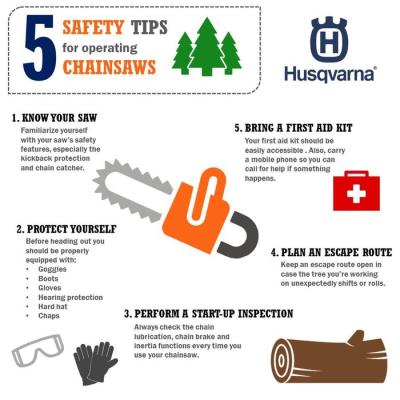
Chain Saw Safety
Chain saws can be labor-saving devices, but they also have great potential for causing severe injury and death if not used properly. At least two persons died from injuries related to chain saws during the first week of cleanup after Hurricane Hugo. This web page cannot address all chain saw potential hazards that you may encounter using a chain saw. If you are not familiar with the proper techniques of sawing, saw operation, or maintenance, read your owner's manual, consult a publication with more detail, or ask your dealer for more information or where training may be available.
If you only have small branches (four inches or less), use a handsaw or axe to cut them. While not suited for cutting such small branches, if you must cut larger trees, limbs and branches, a chain saw can be a very useful tool. If you would only use a chain saw once in a while, you may want to consider having somebody else do the cutting for you.
Chain saw
Read the owner's manual before operating a chain saw for the first time, and note the safety practices. Know how to check the chain and properly adjust the chain tension. Understand how the controls operate. It's important for safe operation.
One of the best safeguards against injury is insuring you are wearing proper protective equipment. Personal protective equipment that should be considered for chain saw use includes:
- Safety glasses or goggles
- Heavy-duty, non-slip gloves
- Sturdy non-slip shoes
- Hearing protection
- Hard hat
- Trim fitting clothes (not loose or ragged long-sleeve shirt and pants)
- Chaps (if you have them)
When you fuel your chain saw, use only the fuel mix recommended by your manufacturer. Never try to refuel the chain saw while it is hot; let it cool first, and always refuel the saw in a clear level area away from debris. If your fuel can does not have a spot, use a funnel to avoid overspill. With the saw clean of any spilled fuel after refueling. Never smoke while fueling or refuel the chain saw in an area with open flames.
There is only one safe way to start a chain saw safely:
- Move at least 10 feet or more away from your refueling area.
- Place the saw in a clear, debris-free area.
- Hold the saw firmly on the ground, as recommended by your manufacturer. While holding it down with one hand, pull the starter rope with the other. The chain should not be moving while the saw is idling.
- Never try to start the saw while holding it off the ground, or by drop starting it. Always follow the manufacturer's recommendations.
Before you start cutting, take some time to prepare the area. Clear away anything that has a chance of interfering with safe operation. Remove any debris that could cause you to slip or lose your balance or accidentally come in contact with the chain. Keep both hands firmly on the saw when moving towards the work area, while cutting, and when moving away.
Kickback occurs when the saw rotates back, or kicks back at the operator, due to the nose of the saw contacting an object or obstruction. To prevent kickback:
- Use a saw equipped with a chain brake or kickback guard.
- Hold the saw firmly with both hands. Grip the top handle by putting your thumb around it.
- Watch for twigs that can snag the chain.
- Don't pinch the chain while cutting.
- Saw with the lower part of the bar close to the bumper, not the top part of the bar near the nose.
- Maintain a high saw speed when entering or leaving a cut.
- Keep your chain sharp and well lubricated.
- Do not reach above your shoulder to cut. The chain is too close to your face in this position.
Many injuries occur because chain saw operators got tired or withstood long periods of saw vibration. It is important to take frequent brakes when using a chain saw.
Cutting down large trees is not simple and should be left to experienced operators who have felled trees before. Limbing requires proper position and constant consideration of kickback potential, the springing back of branches, and the chance that the log may roll. Bucking (cutting a log into lengths) requires knowing how to properly block the log to prevent binding, kickback, or rolling. If you are not familiar with these operations, get more information from your owner's manual, a saw dealer, a book or video, or from an experienced operator.
Additional chain saw safety references:
